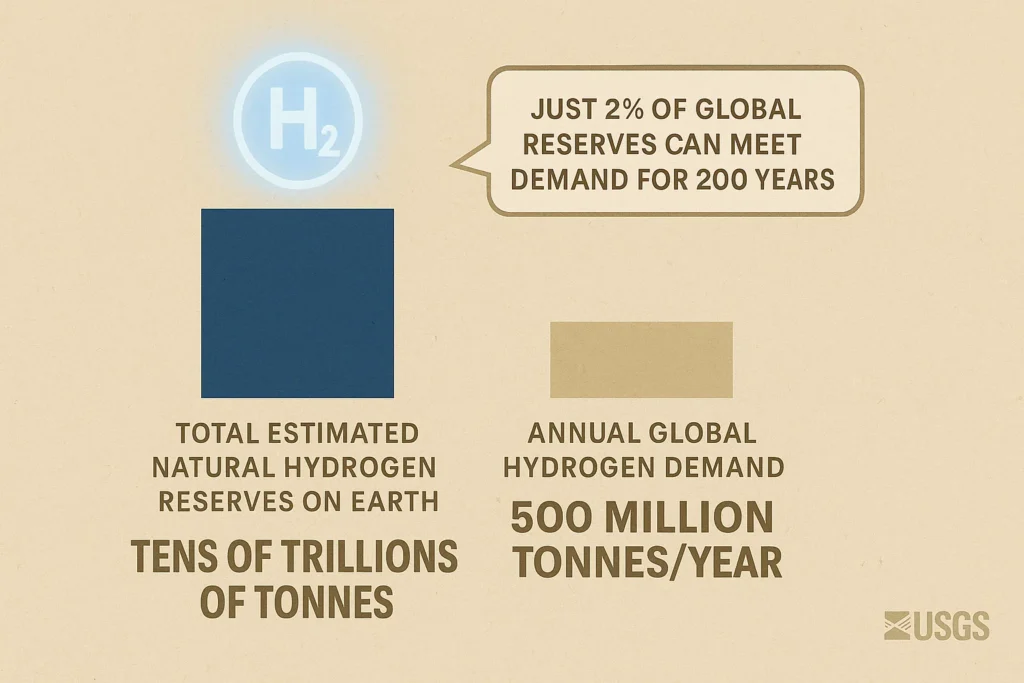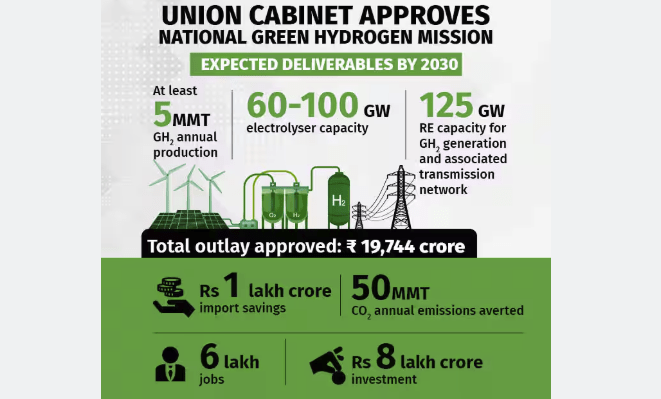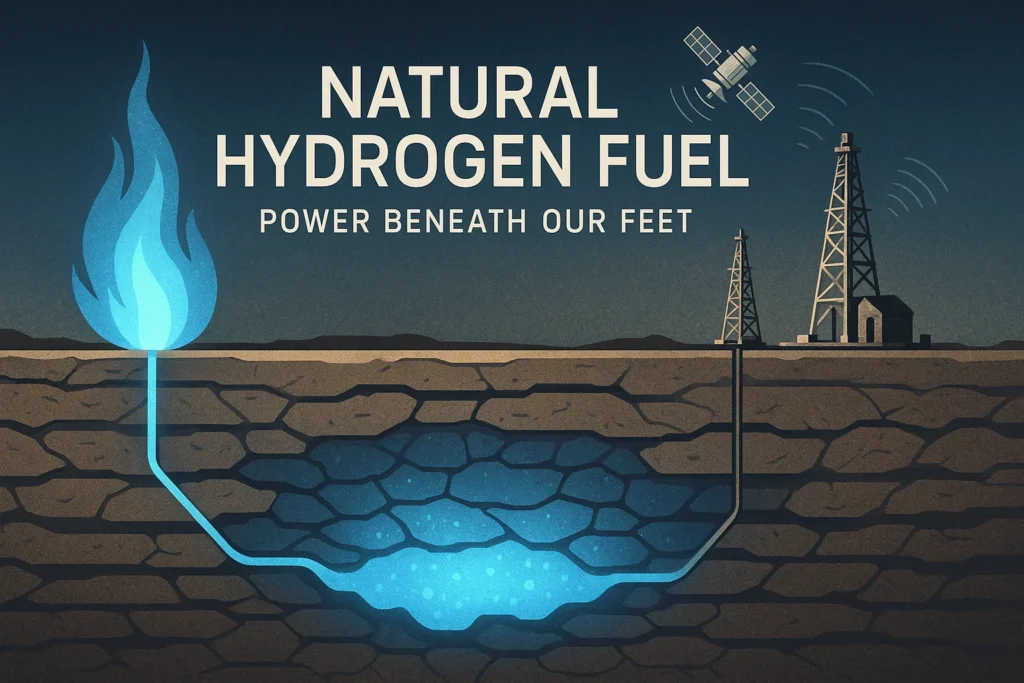For decades, hydrogen has been hyped as the fuel of the future. Now, with the discovery of natural hydrogen fuel bubbling beneath Earth’s surface, the dream of a clean, low-cost, and abundant energy source is turning real—and potentially very profitable.
From unexpected finds in African villages to massive new reserves in Europe and promising geological formations in India, natural hydrogen is stepping up as a potential disruptor in the global energy game.
So, what exactly is it? Where is it found? How is it different from green hydrogen? Most importantly, how can Indian investors stay ahead?
Let’s dive in.
What is Natural Hydrogen Fuel — and Why is It So Exciting?
Today, most hydrogen comes from energy-intensive processes—splitting water using electricity (green hydrogen) or reforming natural gas (grey hydrogen). Both cost a lot and have environmental drawbacks.
Natural hydrogen fuel, however, forms deep underground. It emerges from natural processes such as:
- Serpentinisation (water reacts with iron-rich rocks)
- Radiolysis (radioactive rocks split water molecules)
- Breakdown of deep organic matter

Unlike synthetic hydrogen, natural hydrogen seeps out of Earth like oil or gas—without carbon emissions.
Real-Life Discovery: The Blue Flame in Mali
In 1987, a well-drilling team in Bourakébougou, Mali, set off a blue flame after lighting a cigarette near a borehole. Decades later, scientists confirmed the gas was 98% hydrogen.
That discovery wasn’t an accident—it sparked global interest. Since then, experts have found hydrogen seeps on every continent. Some are even being measured and tapped.
Indian Stock in Focus: Hindustan Oil Exploration Company (HOEC)
HOEC is a small-cap explorer with experience in both onshore and offshore drilling. As India starts to examine ultramafic rock belts, cratons, and volcanic zones for hydrogen, HOEC is well-placed to lead early exploration efforts.
Its projects in Assam and Cambay highlight its geological presence. As hydrogen mapping advances, companies like HOEC could benefit from strategic government tie-ups.
Where is Natural Hydrogen Found?
Geological hydrogen doesn’t stick to one region. It appears in:
- Cratons (Dharwar, Singhbhum)
- Sedimentary basins (Vindhyan, Gondwana)
- Fault zones (Himalayas)
- Basaltic areas (Deccan plateau)
The US Geological Survey estimates that even if just 2% of global hydrogen reserves are usable, they could meet the world’s hydrogen demand for 200 years.

Stock in Focus: NMDC Ltd
NMDC is India’s largest iron ore miner. It operates in hydrogen-prone rock formations. Alongside mining, it’s investing in green energy R&D.
With access to favorable zones, NMDC can partner with scientific institutions to map and possibly tap underground hydrogen stores.
How is Natural Hydrogen Extracted?
Unlike fracking or deep-sea drilling, hydrogen extraction often means collecting gas from shallow seeps. Low-impact techniques are being developed to make this process cost-efficient.
Here’s the big win: Extraction can cost as little as $1/kg, far cheaper than green hydrogen ($4–5/kg).
Stock in Focus: Linde India
Linde isn’t just a gas supplier—it’s building the foundation for a hydrogen-ready India. From storage tanks to distribution pipelines, Linde enables the entire hydrogen value chain.
As natural hydrogen scales up, Linde will likely be instrumental in compressing, storing, and transporting it safely across regions.
What’s Happening Globally?
- US startup Koloma raised $245 million to explore hydrogen zones
- Gates and Amazon backed multiple natural hydrogen ventures
- France uncovered 92 million tonnes of naturally occurring hydrogen
Currently, over 40 companies are exploring hydrogen-rich zones worldwide.
Stock in Focus: Reliance Industries
Reliance isn’t just betting on solar. It’s building one of the world’s largest green hydrogen plants. With the capital, reach, and research firepower, Reliance could easily shift into natural hydrogen, especially as policy catches up.
Its clean energy complex in Jamnagar is expected to shape India’s hydrogen roadmap—and possibly include natural sources in the near future.
What’s the Catch? Why Isn’t It Mainstream Yet?
- Exploration laws are missing in many countries
- Some reserves are scattered or remote
- Infrastructure and safety standards need time to develop
Still, global urgency around decarbonisation means progress will accelerate. Already, governments and research institutions are moving fast to study potential reserves.
What’s the Indian Government Doing?
India’s National Green Hydrogen Mission has a ₹19,744 crore budget. While it focuses on green hydrogen today, government scientists are now mapping geological zones for natural hydrogen.

Expect pilot projects and exploration policy shifts within the next 2–3 years.
Final Thoughts: Is Natural Hydrogen Fuel India’s Next Big Bet?
We may have ignored hydrogen under our feet for decades—but that’s changing fast. Natural hydrogen fuel could become a clean, abundant energy source powering global demand.
For Indian investors, the future looks promising. From explorers like HOEC, to infrastructure enablers like Linde, and giants like Reliance, many listed companies are aligned with this emerging shift.
This is the time to stay informed, spot early opportunities, and position smartly.
Because when the world starts tapping hydrogen that’s already waiting underground, the winners will be those who looked below the surface—both literally and financially.
Invest in tomorrow’s energy today — open your Angel One account and explore opportunities in emerging clean tech stocks!
FAQs
1. What does natural hydrogen fuel mean?
Natural hydrogen fuel means hydrogen gas that forms underground through natural geological processes like serpentinisation and radiolysis, without any human-made intervention.
2. How does natural hydrogen differ from green hydrogen?
Natural hydrogen forms naturally and seeps from the Earth, while green hydrogen requires electricity from renewable sources to split water molecules in a lab or industrial facility.
3. Where can India find natural hydrogen?
India finds potential natural hydrogen reserves in regions like the Dharwar and Singhbhum cratons, Vindhyan and Gondwana basins, and tectonic areas like the Himalayas.
4. Why does natural hydrogen cost less than green hydrogen?
Natural hydrogen costs less because it doesn’t need expensive infrastructure or energy to produce—it simply needs exploration and direct extraction from naturally occurring seeps.
5. Which Indian companies work on natural hydrogen segments?
HOEC explores geological zones, NMDC operates in hydrogen-favorable formations, Linde India builds hydrogen infrastructure, and Reliance invests heavily in future hydrogen technologies.
6. Does natural hydrogen support clean energy goals?
Yes, natural hydrogen supports clean energy goals by offering a zero-carbon fuel source that requires no combustion of fossil fuels for production.
7. Can natural hydrogen replace fossil fuels?
Natural hydrogen can gradually replace fossil fuels in sectors like transportation, power, and industry—especially if extraction becomes economically scalable.
8. What steps is the Indian government taking?
The Indian government is funding green hydrogen projects and starting geological surveys to locate natural hydrogen zones under the National Hydrogen Mission.
9. Who has discovered natural hydrogen reserves globally?
Scientists and energy firms have discovered natural hydrogen reserves in Mali, France, the United States, Australia, and several other countries.
10. What challenges limit natural hydrogen adoption?
Exploration gaps, unclear policies, remote locations, and limited extraction technology currently limit natural hydrogen’s widespread adoption, but solutions are evolving quickly.
Related Articles
Buy Gold on Akshaya Tritiya? Only If You Know This First






